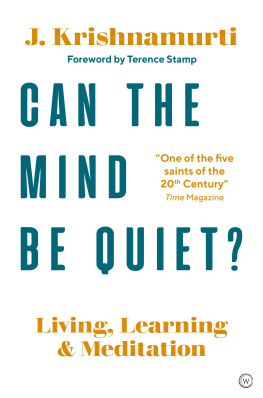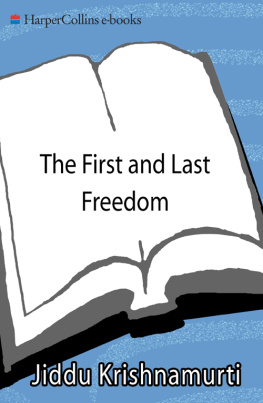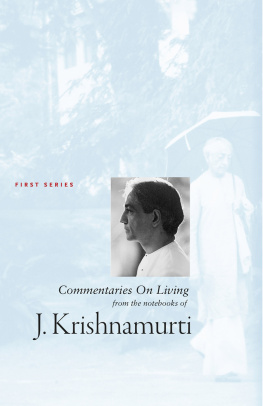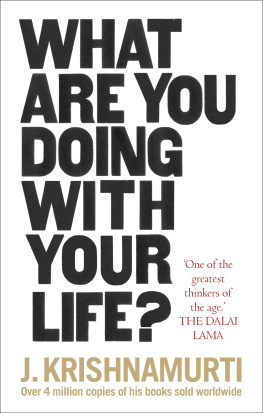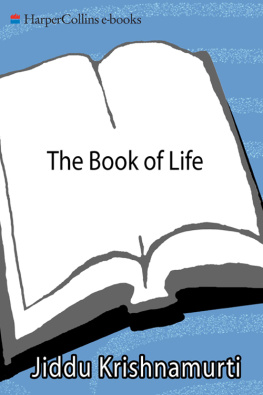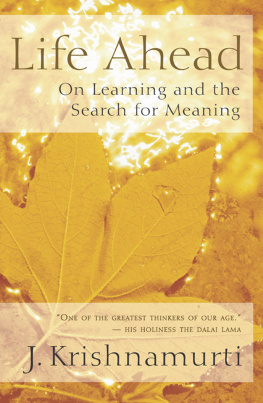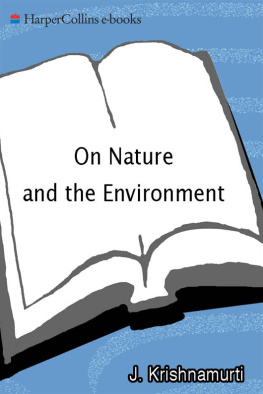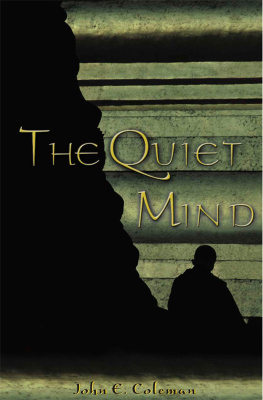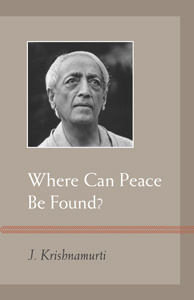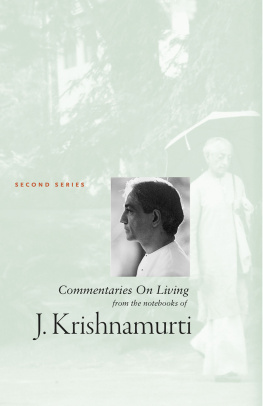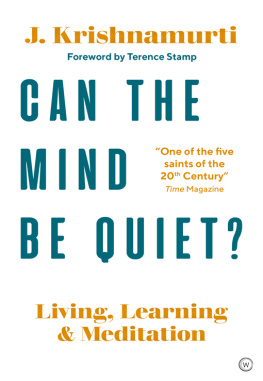Krishnamurti - Can the Mind Be Quiet?: Living, Learning and Meditation
Here you can read online Krishnamurti - Can the Mind Be Quiet?: Living, Learning and Meditation full text of the book (entire story) in english for free. Download pdf and epub, get meaning, cover and reviews about this ebook. publisher: Watkins Media, genre: Religion. Description of the work, (preface) as well as reviews are available. Best literature library LitArk.com created for fans of good reading and offers a wide selection of genres:
Romance novel
Science fiction
Adventure
Detective
Science
History
Home and family
Prose
Art
Politics
Computer
Non-fiction
Religion
Business
Children
Humor
Choose a favorite category and find really read worthwhile books. Enjoy immersion in the world of imagination, feel the emotions of the characters or learn something new for yourself, make an fascinating discovery.
- Book:Can the Mind Be Quiet?: Living, Learning and Meditation
- Author:
- Publisher:Watkins Media
- Genre:
- Rating:5 / 5
- Favourites:Add to favourites
- Your mark:
- 100
- 1
- 2
- 3
- 4
- 5
Can the Mind Be Quiet?: Living, Learning and Meditation: summary, description and annotation
We offer to read an annotation, description, summary or preface (depends on what the author of the book "Can the Mind Be Quiet?: Living, Learning and Meditation" wrote himself). If you haven't found the necessary information about the book — write in the comments, we will try to find it.
Can the Mind Be Quiet?: Living, Learning and Meditation — read online for free the complete book (whole text) full work
Below is the text of the book, divided by pages. System saving the place of the last page read, allows you to conveniently read the book "Can the Mind Be Quiet?: Living, Learning and Meditation" online for free, without having to search again every time where you left off. Put a bookmark, and you can go to the page where you finished reading at any time.
Font size:
Interval:
Bookmark:
CAN THE MIND BE QUIET?
CAN THE MIND BE QUIET?
LIVING, LEARNING AND MEDITATION
JIDDU KRISHNAMURTI

CONTENTS
EXPLORATIONS WITH KRISHNAMURTI
Along with Krishnamurtis public talks, his dialogues with leading 20th-century thinkers such as Renee Weber, Iris Murdoch, Jonas Salk, David Bohm and Huston Smith are well known. In between these hundreds of meetings, Krishnamurti was also available for private interviews and conversations with those who wished to meet him. These were not recorded and note-taking was discouraged.
Compiled here are sixty such conversations, previously unpublished, recalled and written down by Krishnamurti in the late 1960s and early 1970s. They contain probing inquiries into such topics as the self and consciousness, the essential qualities of good education, and the meditative and religious mind. As with all of his writings, the style is direct, eschews rhetoric and states deep truths as obvious and factual information, available to any who will listen. The pieces also include Krishnamurtis much-loved descriptions of nature.
The book is divided into three parts, representing far-reaching explorations into the areas of living, learning and meditation, highlighting Krishnamurtis radical approach to each.
FOREWORD
I met Krishnamurti for the first time in Rome in 1968, while I was working on a movie with Federico Fellini, the great Italian director. I spoke no Italian, so he had given me an interpreter, who also happened to be his personal astrologer. One day she said to me, Youve been invited to a lunch with Krishnamurti.
I said, Whos Krishnamurti?
She then replied, in a hushed voice, as if I should know, Well you know hes Krishnamurti.
I asked, Okay, is he a film director?
No no, she said, hes a sage.
Now I was 27 and famous, but really I am just an East End spiv and right then I was winging it. The only sage that I knew of went in the stuffing that my mother made at home for our roast dinners. All the same, I was interested enough to go along to this lunch party. It was only years later that I found out how I actually came to be there.
Fellini had an amazing script that he wanted to shoot. However he was short of money, so he asked Vanda Scaravelli, the eminent yoga teacher and well-connected society figure, for assistance. She knew Krishnamurti, and Fellini asked to be introduced to him next time he was in Rome, thinking I suppose that he might provide some funding.
A few months later Krishnamurti was in town, and she arranged for them to meet. Hearing that he loved movies, Fellini cut together about 15 minutes of the rushes of the film that he and I were making. He then showed it to him to break the ice, and apparently, when the short film finished, Krishnamurti said Id like to meet that boy (meaning me), which was why I was invited to lunch.
When I arrived the place was crowded, but I still ended up at a table opposite Krishnamurti himself. We didnt speak at all. But, because I was staring at him, he continually lowered his eyes out of politeness. I remember thinking that I had never met anybody like that. It was very unusual. Then after the lunch he was answering questions from the press people there and his secretary Alain Naud came over to me and said, Would you like to go for a walk with Krishnamurti? I said yes.
So he and I went out for this long walk around the suburbs of Rome. And not having had the nerve to speak with him during lunch, I suddenly couldnt stop chattering. At a certain point on the walk we stopped and he put his hand on my arm and said, Look at that tree. And I lookedit was a tree. I looked at him. He smiled. I smiled. We carried on walking. I carried on talking. Ten minutes later he stopped me again and said, Look at that cloud. And I lookedagain, cloud. It wasnt special, not lit from within or anything like that: it was a cloud, thats all. On we went, and I kept talking.
And that was my first meeting with Krishnaji. However, I was never the same after that meeting. Something shifted. He did something to me, which I understood years later: he used his presence to pause my own thinking. And something inside started reaching back out towards me.
From then on, every time I saw that he was giving a talk, I would try and go, and likewise he would always try and make sure that I was invited. I often wouldnt really get what was being said, but unbeknownst to me I was being refined. In later conversations the same thing would happen: we would start off talking about material things like shirts and shoes, and yet a shift would occur. His tone of voice would not necessarily change, but something subtle would take place. I can only liken it to Cole Porters lyric, How strange the change from major to minor. It took me maybe 15 years to understand sayings like: When the eagle flies it leaves no mark, and The observer is the observed.
I might not have been sure about what he was saying, but there was always this shift.
Terence Stamp
PART ONE
EXPLORATIONS INTO LIVING
WE DO NOT SEE, WE DO NOT HEAR
The north wind blew hard and cold, wiping away the fog, the smell of the town, the exhaust and the foul air. The mountains were very clear. The air was brittle, sweeping everything before itthe dead and dying leaves. You could see very far to the gap between the islands and you could almost see every bush and every leaf on the hill. That strange light that exists only in California was more penetrating than ever. You really should see these hills in this light, with the blue sky beyond them, and then you would know the extraordinary beauty of the land. The sun was on the sea, this morning one vast sheet of silver. It was good to look at the light of the water and let that light enter into your heart, and to live there with that light and nothing else, with no thought, without tomorrow or yesterday, and to let the north wind blow away all the inanities, the ugliness, the violence and the stupidities that man has built into himself by his own thought and fear. Let all that be swept away and have that light and nothing else.
You have often said be nothing, completely destroy everything, the good and the bad, and withdraw into silence, into nothingness. Arent you really teaching total annihilation of the ego and all the works of the ego? You are really saying to people, live a life of nothingness and from that nothingness act. This is what the Bhagavad-Gita or the Upanishads say in their own way: complete and total annihilation of the me, the ego, the super-ego. How is this to be done? Does it come about through meditation or through good work? Is it a reward for righteous behaviour? How does it happen?
There are two kinds of action. One brings you reward, and the doing of it strengthens the ego, the me. The other kind of action, the action which you love to do, has no reward or punishment and is not concerned with what the neighbour says, or with gods or with the priests or with belief. You do it because it is the only thing to do.
You rejoice in the very doing of it, not for heaven or the avoidance of hell. You just do it and in the very doing of it is the delight. This action is of freedom from society and has nothing whatsoever to do with morality. This action is from nothingness. When there is this, you can look at the world from that silence of nothingness.
You ask how this happens. Thought can only go as far as its own distance and dimension, for it is tethered. Thought, however bright, clear, perceptive, is still part of the known, and the known is not that nothingness. Thought cannot destroy the known, for it is itself the already known. But thought must exercise itself to its fullest width and height and see its own barren activity. Neither is it through organised meditation, for as long as there is the meditator, meditation is within the field of the known. What is important is the ending of the meditator. So it is not organised meditation with its systems, methods and goals, nor is it the pursuit and refinement of thought. It is the clear eye that sees and the clear heart that hears. The hearing and seeing of the ego is one thing, the seeing and hearing without the ego is another. The one perverts and distorts, the other simply sees and hears. This hearing is from the silence of nothingness. The total denial is the total action.
Next pageFont size:
Interval:
Bookmark:
Similar books «Can the Mind Be Quiet?: Living, Learning and Meditation»
Look at similar books to Can the Mind Be Quiet?: Living, Learning and Meditation. We have selected literature similar in name and meaning in the hope of providing readers with more options to find new, interesting, not yet read works.
Discussion, reviews of the book Can the Mind Be Quiet?: Living, Learning and Meditation and just readers' own opinions. Leave your comments, write what you think about the work, its meaning or the main characters. Specify what exactly you liked and what you didn't like, and why you think so.

